
To access these books, click here.

To access these books, click here.
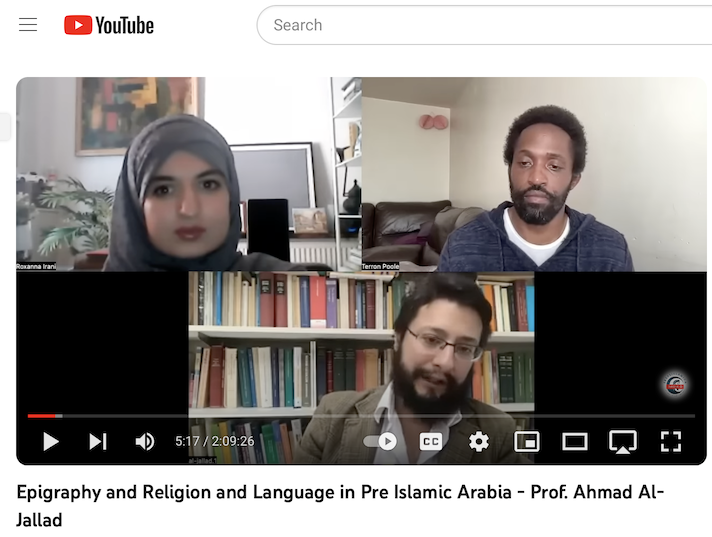
This is an excellent Youtube talk by Ahmad al-Jallad on the evidence from the rock inscriptions and graffiti from the Arabian Peninsula. Also check out his excellent book on religion and ritual in the Safaitic graffiti.
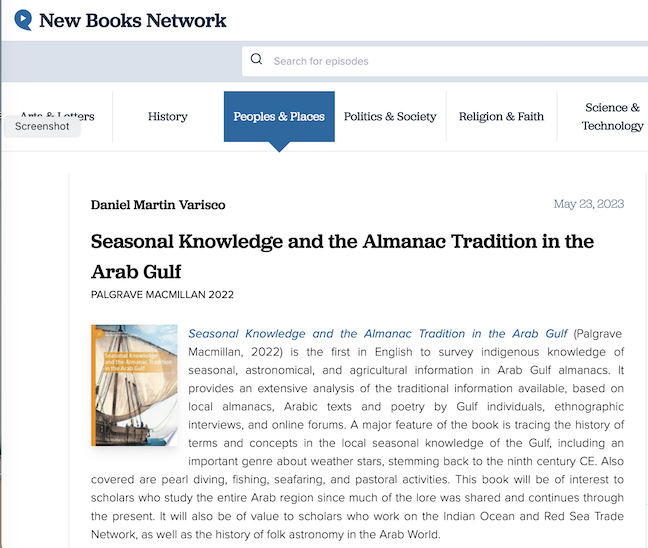
My podcast with Ahmed AlMaazmi and Tamara Fernando is posted online on the New Books Network.
I will be giving a book launch on my recent book on Gulf almanac lore via Zoom for the Qatar National Library on February 22, 2023. Details about registering for the talk are provided at https://events.qnl.qa/event/opOp5/EN. Please feel free to spread word of the talk. Details on the book are at:https://link.springer.com/book/10.1007/978-3-030-95771-1.
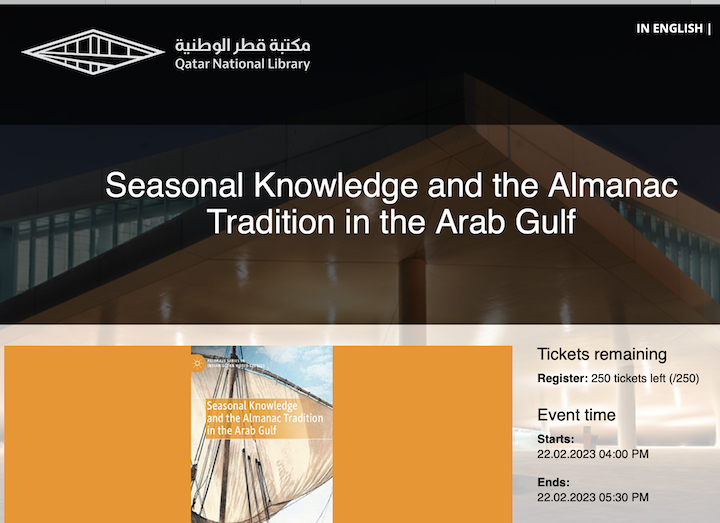
In 1904 the proud D.D. Methodist Robert William van Schroik, at the age of 61, boarded a German steamer in New York for a 70-day trip to the Holy Land. The cost was $550 to cover the entire trip on sea and land. The number of travelers on the ship was over 800. This was obviously not the first Protestant American pilgrimage to the Holy Land and the travel book that was produced is nowhere near the quality of the classic The Land and the Book, first published in 1859 by the American missionary William Thomson. Our 1904 journeyman called his book The Book and the Land, a pale reflection of the earlier classic. This tale of Sunday School biblical adventure has a dedication: “the bravest of all Crusaders and Discoverers, Christopher Columbus,” although the direction of sail was reversed. If you are not interested in reading the dull prose of this anti-classic, you can follow the highlights in the post below.

It took eight days to reach Madeira and the first major stop after Gibralter was at Algiers. The ship docked at 1:30 am while the intrepid traveler was taking a bath. Once ashore the fact that he did not know Arabic or French limited his visit. As he laments, “In two or three instances by motion of lips and hands, and even feet, I tried to make myself understood, but it was useless, and, like many others, I resigned myself to my environments.” He was very much the precursor of the “ugly American”, as shown in his comment on the Arabs of Algiers: “Our drive to the Arab quarters, where poverty, disease, imbecility, and squalor were much in evidence to our optical and olfactory senses, showed us how wide is the gulf which separates our Christian, Bible loving America from this country, where the inspired word of God is scarcely seen or read.” I am not sure if our Robert expected to find a Gideon Bible in his hotel room, but I suspect there was none since the Gideons did not start placing Bibles in hotels until 1908 and that was in Montana.
Like many other steamer-rolled Holy Land visitors, it was the idea of walking where Jesus had walked that excited this lay Methodist. For sure he was no “innocent abroad” in the wake of Mark Twain. He shared his steamer suite with two Presbyterians, a reverend and a missionary. As he explains, “We are all good travelers, untroubled by seasickness, and so far we have not missed a meal. We joke each other occasionally about our denominationalism but as all things are foreordained, according to their creed, and we Methodists have the right to choose the best on sea and land, I have chosen them to be good fellows to room with on a ship. So our Calvinism and Arminianism combine beautifully, and stateroom No. 628 is doing its full part to hasten the millennium.” Over a century later the hastening of the prophetic Millennium appears to be ongoing.
After scenic stops in Malta, Athens and Corinth, they reach Constantinople. Here there was a lecture that was greatly appreciated by our itinerant Methodist: “Mr. Pears ‘s lecture was especially fine in the information he gave concerning the museum where many of the relics are unmistakable proofs of those Bible statements most severely criticized. For example, the stone in the museum, positively from Solomon’s Temple, which speaks of the penalty imposed on those who profane the temple fully answers the criticisms of those who tell us that Jesus, a youth, could not have driven the people with a whip from the temple, as it would have created a riot throughout the city.” Whether or not the museum held the foreskin of Jesus is not mentioned. It should be noted that Charlemagne, who said the holy prepuce was given to him by an angel, presented the holy relic to Pope Leo III in 800 CE in exchange for recognition as king. Apparently it disappeared at a later time from Rome.
Eventually the tour reached Beirut, where some 21 brave ones took a train to Baalbek. Our traveler lists his companions: “Of the other members of our party, missionaries, preachers, bankers, business men, two were from Iowa, two from Illinois, one from Arkansas, one from Louisiana, two from Massachusetts, two from Smyrna, two from Beirut, one from Kansas, one from Oregon, one from Sidon, Syria, one from Toronto, Canada, one from Sofia, Bulgaria, three from Saint Louis, Mo., one from Ohio, and one from Michigan.” It was indeed a cosmopolitan group of pilgrims. Yet another lecture was provided, where it was noted that some people say Baalbek was founded by Cain some 133 years after the creation of Adam, although some suggest “Nimrud, the mighty hunter.” But here is the clincher: “There is little doubt that it is the Baalath where Solomon built a castle in honor of the Queen of Sheba, and where he also built a temple to please his concubines after he departed from the worship of God to the worship of Baal.” What a gentleman the ancient Israelite king was, taking care of his hundreds of lust-filled concubines after he got religion.
Arriving in Damascus they were put up in the luxurious Grand Hotel D’Orient of the Kaonan Brothers proprietors, but they quickly went into action. “We took carriages at once and drove to the street ‘called Straight’ and saw the house of Judas, the first house Paul visited in Damascus and where the scales fell from his eyes when Ananias put his hands upon him. Near this house was the fountain where Paul was baptized.” In the evening they watched the sunset at a place overlooking Damascus, which they were told was where Muhammad received his first revelation from Allah. And even more, “We also saw the maple tree, called ‘the tree of the holy prophet,’ said to be one thousand three hundred years old. It is of fifty feet girth, over sixteen feet diameter.” They also visited the grave of Fatima, Muhammad’s daughter. It was a very diligent interfaith agenda in this part of Syria.
Leaving Damascus, our emotional Methodist penned the following praise: “Damascus! Star and Crescent combined; Emerald of Syria; Eden of our first parents; Abraham’s mount of vision where he had his first revelation of God; where Paul, too, received the heavenly vision to which, like Abraham, he was not disobedient; where Mohammed got an intenser love for the paradise not of earth Damascus! May all that is noble, beautiful, and magnificent in thy long history be repeated and more than duplicated in all the coming ages, and all that has been dark, cruel, superstitious, and unworthy of thee be forever forgotten.” I suspect that this tribute has yet to be translated into Arabic.
Now the sacred object of the tour was close. “A whole book could be written of what we saw and thought at Nazareth, Galilee, and Samaria, where so much of our Saviour’s ministry was spent, but we must on to Jerusalem,” writes our impatient Methodist pilgrim. It was clearly not a whole book he chose to write. On the way the sites of biblical dimensions were almost everywhere. “Our guide pointed to the hill where Samson was born, but we learn that many other places contend for the honor of having been his birthplace.” Imagine that. Perhaps there was a lock of Samson’s hair back in the Istanbul museum.
In Jerusalem he first visited the American Colony, where he was served cake and hot tea. “As we sallied forth that which impressed me was the cosmopolitan character of the people I met. Jews, Arabs, English, French, Scotch, and Americans were to be seen, and twice as many other nationalities were represented,” notes our pilgrim. Now all of Bible history came to light. “I found here the sublime and ridiculous in most convenient juxtaposition. For example, here was the very spot from which the earth was taken out of which Adam was created, and just a few yards away was his tomb. Here was the very spot where the crucifixion occurred, the brass hole wherein the cross was placed marking the center of the earth and, in the cellar of the church, the shrine where Helena, mother of Constantine, discovered in a vision the true cross. Everything is here.” But, “the strangest thing of all is the credulity of thousands upon thousands who accept these claims with the utmost sincerity.” Then, he continues: “All the surroundings show the genuineness of the Bible narrative recorded in the fifth chapter of the gospel by John.” I believe he says this with the utmost sincerity.
Jerusalem is, of course, close to Jericho and the Dead Sea, so off our hero went. “I confess to some nervousness, as our carriage, drawn by three horses, would swing perilously near the precipitous cliffs below the roadway. To add to my trepidation, the drivers are proverbially careless, and often give free vent to their propensity for driving past the teams ahead of them.” It seems he survived, since he later wrote his travelogue. “At about half the distance from Jerusalem we stopped to rest the horses at the Inn of the Good Samaritan, where many curios were purchased. The old inn bears every mark of being on the site of the hostelry to which a kind-hearted Samaritan would have carried a man who had been robbed and wounded and left half dead by the thieves.” Our dear Methodist does not report finding any wounded Samaritans on this part of the trip, but I am sure he would have taken such a person to this very inn. Later he left the carriage to visit the site where Elijah fed the ravens. He does not say if he saw any ravens and what he fed them if he did; nor was there any sign of a chariot in the sky. The heat was rather intolerable; he estimated it at about 150 degrees. Fortunately the group arrived back in Jerusalem in time for lunch.
The goal of the voyage was The World’s Fourth Sunday School Convention, held in Jerusalem for three days in April. “It was replete with interest. For the full report I refer my readers to the ‘Official Report of the Cruise,’ which is to contain stenographic reports of all the lectures, sermons, addresses, etc., including the convention, from the time we left New York, March S, until our return. May 19.” Our stenographic Methodist then lists the number of attendees by nationality, there being 701 Americans out of a grand total 1,526 individuals representing 23 countries, including six from Japan and one from New Zealand. It was an international Sunday School fest not unlike the Mohammedan pilgrimage.
Eventually the host returned to New York. The parting thought in the book is praise of travel.
“The only know the world is to see it, and the present facilities for travel offer every opportunity of reaching even ‘earth’s remotest bound.’ What are you toiling for? Why are you saving money? To buy another farm? to add to your mortgage or bank account ? Of what avail will it all be if you only come to have a plethoric exchequer and a lean intellect ? mind your best capital? Isn’t your mind your best capital? isn’t it worth your while to drop the mad pursuit wealth or pleasure and fit yourself, by travel and observation, to better act your part in life’s soon to be ended?”
Amen to that. The plethoric exchequer would indeed be a sad way to live.
And here is our pilgrim at last:
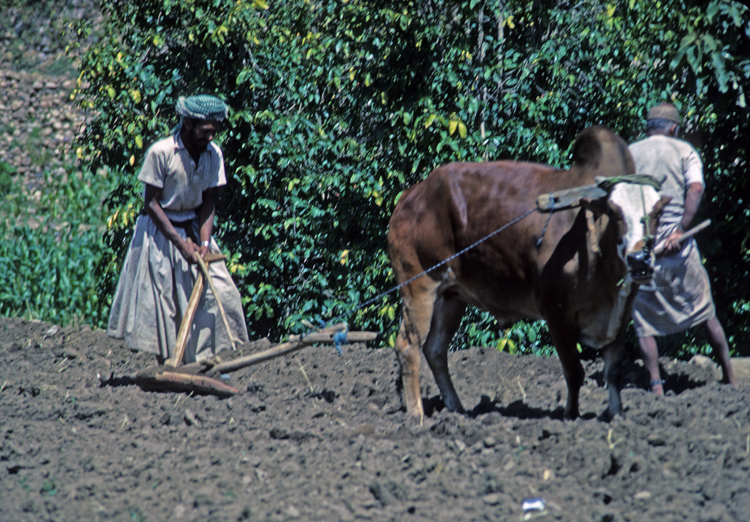
The early major civilizations in the Middle East and Asia with their head start several millennia ago had one thing in common: an agricultural base that fed not only people but led to development of states and their services. Major river systems like the Nile and Tigris/ Euphrates, the Ganges of India and the Yellow of China were important centers for mass production, but at the same time small-scale farmers utilized a variety of water sources or practiced dry farming in a variety of ecozones across continents. Although there were periodic famines due to climate variability or political violence, until the start of the last century many countries were able to grow most of the food needed for their citizens and several were major exporters.
In 1798 Parson Thomas Malthus, an economist in his day, suggested that humanity faced a major food crisis. At that time the world population was around one billion; today it is closing in on eight billion. Malthus argued that population growth, if unchecked, grew at a geometric rate over time, but food production increased only arithmatically; thus it was inevitable that there would be food shortages, especially for the poor. At the time Malthus was unaware of later advances in agricultural technology, but his warning still serves a purpose. There needs to be a way to ensure that any form of food production is sustainable. The so-called "Green Revolution" that prophesied major dams and irrigation schemes as the wave of the future has indeed been a wave, but far more destructive to the environment and local agricultural traditions than anticipated.
If we are to recalibrate the model of Malthus today, it is less a mathematical issue than a bureaucratic one fueled by monopolistic profit making. In the United States about half of all family-owned farms are considered small-scale, but they generate only 21% of production. There has been a general decline in the number of farms in the U.S. from a high of 6.8 million in 1935 to about 2 million in 2021. The problem is even grimmer outside the industrialized West, where overall crop diversity has declined by 75% in a century, in large part due to the domination of commercial seeds, fertilizers and pesticides. Not surprisingly the need for food aid has grown in recent years.
The case of Yemen has become a poster child for food aid since the humanitarian crisis began in a war that started in 2015. As noted by the World Food ProgramThe current level of hunger in Yemen is unprecedented and is causing severe hardship for millions of people. Despite ongoing humanitarian assistance, 17.4 million Yemenis are food insecure. The number of food insecure people is projected to go up to 19 million by December 2022.
The rate of child malnutrition is one of the highest in the world and the nutrition situation continues to deteriorate. A recent survey showed that almost one third of families have gaps in their diets, and hardly ever consume foods like pulses, vegetables, fruit, dairy products or meat. Malnutrition rates among women and children in Yemen remain among the highest in the world, with 1.3 million pregnant or breastfeeding women and 2.2 million children under 5 requiring treatment for acute malnutrition.
Historically, the rich and fertile land of Yemen, stemming back three millennia to the ancient kingdom of Sheba (Saba), was the bread basket of Arabia. During the 13th century, for example, Yemen boasted diverse crop production from the hot and dry Red Sea Coast to cultivated mountain terraces at the highest point on the Arabian Peninsula. One of the ruling sultans, al-Malik al-Ashraf Umar, interviewed local farmers and wrote a major treatise of the agriculture practiced in Yemen in his time. There were, of course, periodic famines, but overall Yemeni farmers were able to feed themselves and export grain north to Mecca. After the civil war in the 1960s toppled the long-lasting Zaydi imamate, the resulting republic in Yemen’s north received major development aid for improvement of agriculture, but most of this had limited impact at the local level. As the population grew, from less than seven million in 1976 to now reaching 30 million, and unregulated drilling of tubewells drew down aquifers drastically, food production has declined precipitously. There is still fertile land and Yemen’s limited water resources can be used in a sustainable manner, but the ongoing war has ground the economy to a virtual halt. Farmers are still growing food, but it is not clear how much. The fact remains that without imported food aid, there would be a massive famine.
While there is little choice not to send massive amounts of food aid to Yemen to meet the emergency, there is also an urgent need to revitalize the rich agricultural production systems of Yemen, many of which rely on dry farming techniques developed over centuries. Current violent conflict makes such an emphasis difficult, but there are opportunities to work with local Yemeni communities and NGOs. The need is not for foreign technical know-how, an approach that has been ineffective and a waste of funding, but to assist Yemenis in rebuilding terrace walls and using their own seeds, especially for food crops like sorghum which grow well at most elevations. Without contributing to Yemen’s food sovereignty, the ability of Yemeni farmers to grow their own food in harmony with the environmental constraints and not overly dependent on foreign inputs, food aid is a bandage on a gaping wound.
One of the main contributors to the decline in traditional varieties of seeds and crops around the world is the corporate monstrosity previously known as Monsanto. Fortunately, Monsanto with its GMO push never made inroads in Yemen, but the results have been negative elsewhere. The destruction from its pesticides and control of seeds has been known for over two decades. The negative impact has been especially hard in India, which the film Bitter Seeds explores. By pushing GMO seeds, especially cotton, that turned out to be problematic and an economic burden, farmers were locked into dependence on imported seeds and this led to a decline in the local seed varieties, many of which were well suited to local environments after centuries of use. The fact that major aid donors such as the World Bank have pushed GMO seeds despite the enormous economic and bureaucratic burdens these impose on developing nations, has reduced rather than aided food production, especially given the focus on cotton. Regardless of the negative health impact of GMO foods, the overriding issue is saddling local small-scale farmers worldwide with expensive, imported production needs and has devastated locally adapted crop varieties.
Anthropologist Joeva Sean Rock has just published an ethnographic study entitled We are not Starving: The Struggle for Food Sovereignty in Ghana. He shows that despite the promise of improved cotton varieties, the results were far less promising and actually disrupted local food production, which has been predominantly small-holder. In addition, by talking to Ghanian farmers and activists, he realized that the food aid providers started with the assumption that local farmers did not know how best to farm and they needed foreign assistance or they would starve. Instead of working with farmers to build on their knowledge honed over centuries through all kinds of climate change, they simply presented an unsustainable package deal with strings attached from the outside.
The lesson for the future of Yemen’s agriculture is obvious. Yemeni farmers have been successful in small-scale food production for centuries. While no one is proposing going back to reliance on simple scratch plows and animal labor as a permanent solution, the old systems can be built on and updated with appropriate changes. A major proponent of responsible change is the Yemeni NGO YASAD, the Yemeni Association for Sustainable Agricultural Development, the activities of which have been curtailed as the Yemen war wages on. Food aid must continue to avert famine, but aid to revitalize Yemeni farmers’ food production is just as urgent a need. Major donors like the World Bank, UNDP and FAO, USAID and all other interested agencies should find ways to help Yemeni farmers and local communities directly, not by imposing outside methods but allowing Yemenis to expand on their own successes.
Daniel Martin Varisco is an anthropologist and historian who conducted ethnographic research on highland springfed irrigation in Yemen in 1978-1979 and returned more than a dozen times as a development consultant and historian. He is currently translating the 13th century agricultural text of al-Malik al-Ashraf and other Rasulid documents on agriculture.
This post was republished on Informed Comment: https://www.juancole.com/2022/09/sovereignty-farming-suffers.html
This is a fabulous new book from the University of California Press discussing photographs from late 19th and early 20th century Palestine from seven notebooks by Wasif Jawhariyyeh (1904–1972) that contained some 900 images. And it is available for download as open access. Below is one of the images, as well as a flyer for a concert in Jerusalem by Umm Kalthum. Check it out…
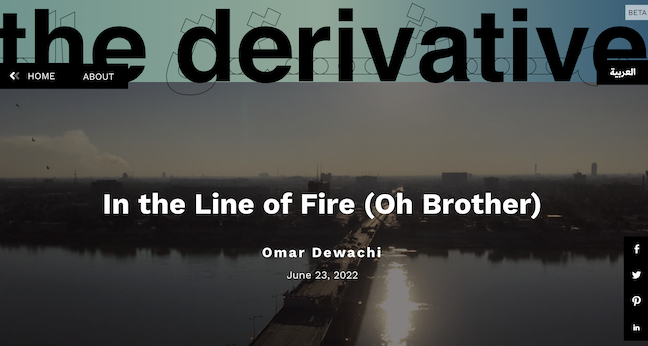
Omar Dewachi, an anthropologist who was an Iraqi physician during the Gulf War, has published an article from his forthcoming book, which is entitled “When Wounds Travel: Ecologies of War and Healthcare East of the Mediterranean”.
Here is the start of the article. To read the whole article, click here.
A call from the surgical residence in the outpatient clinic informing us of a new admission to the ward. “It is a burn case,” he warns, “Najwa Abdul Hadi, female, in her early 30s, transferred from a local hospital with burn injuries covering nearly 90% of her body following the explosion of a cooking gas container at her home.” Mohammed and I, the two junior doctors on the floor, rushed to the other side of the ward, impatiently waiting at the service elevators to receive our new admission. Only days into our surgery rotation on the second floor of Baghdad Teaching Hospital—Iraq’s largest referral hospital and medical complex—we had finished medical school a month earlier, in May 1997. This was our first job as “real” doctors. Unlike Mohammed who had studied medicine at another med school, I had spent the past 6 years of my training in this teaching medical complex, and was familiar with the ins and outs of the hospital. Still, this was a new terrain for me. No longer a student, this night was my first time “on call”, and I was getting a bit anxious.
For many of us who lived through the first Gulf war, the sight of a burnt body became a doppelgänger of that war. One such doppelgänger was the charred body of one Iraqi soldier in the carnage of tanks which littered what became known as the “Highway of Death”—where the retreating convoys of thousands of Iraqi soldiers from Kuwait were attacked by the US military with Depleted Uranium (DU) weaponry. DU was developed in the US during the Cold War era and experimented with for the first time in real combat during the 1991 Iraq War. It was designed to burn through thick metal surfaces, namely tanks and fortified armored vehicles. The artillery tips burn through the thick alloy, incinerating them inside and out upon impact.
Another image of that war, which I witnessed for myself, was the silhouette of two skeletal remains fossilized into the concrete walls inside the famous Amiriya Shelter, where 408 people were killed with so-called bunker busting, “smart bombs.” US pilots nicknamed them “the hammer” for their massively destructive capabilities and wide-ranging blast radii. I visited the Amiriya shelter in 1991 after the cessation of the bombing campaign. I remember thinking that it was a blessing that those in the bunker did not suffer for long. It was more merciful and dignified to die on the spot than to endure the effects of surviving such brutalization.